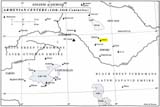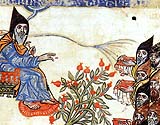|
"… during the reign of King Georgi, at the time when the filthy and accursed T'imur plundered our lands, I, Baron Martiros, son of Shahansha, and my wife, Baroness Ladam, daughter of Baron Arlut'ay, son of Jum, grandson of the prince of princes Prosh, after much effort and expense rescued, through our honest means, this holy ancestral gospel, which had fallen captive into the hands of foreigners." The Armenian medieval manuscripts were almost exclusively produced in monasteries. As a rule, manuscripts were commissioned by the members of Armenian noble family clans (nakharar), as a form of religious propitiation on behalf of their families or progeny. Therefore, most of the Armenian manuscripts have extensive colophons, with names of the scribes, illuminators, and patrons who commissioned the work. Their names would be invoked and prayer offered every time the manuscript was read. Valued as sacred objects, manuscripts would be handed from one generation to another or one owner to another, and each would write the inscription or lengthy colophon to mark the ownership and circumstance of the transmission. The Gladzor Gospel has 2 colophons and 17 inscriptions. The original colophon, which would state the name of the scribes and precise dates of the production, is lost, probably removed when manuscript left the monastery of Gladzor. The earliest colophon is from the year 1377, written by Baroness Vakhakh (Vaxax). She was member of Orbelian nakharar family married to Baron Arlut'ay, member of the Proshian nakharar family, the protectors of Gladzor monastery. Her colophon mentions that "this [gospel] was written in Vayoc' Jor, at the monastery which is called Glajor" and that in the year 1377 come into her possession. However, this colophon also points towards the Orbelian nakharar family as a possible patron who commissioned the manuscript in the first place. The Noravank' was the principal monastery of the Orbelian nakharar family, and at this time there in resided illuminator and sculptor Momik, as well as a group of the illuminators with similar styles as the Evangelist Painter from the Gladzor Gospels. This group also proffered 11th century exemplars as one used for the Gladzor Gospels. The Eghegis monastery, suggested as another possible scriptorium where work on the Gladzor Gospels started, was much smaller, but also under Orbelian patronage and in the same cultural circle. In good Armenian tradition, the Baroness provides considerable genealogical information about herself and her family listing a number of important personages from her and her husband's family lines. She also names her children, a daughter Ladam who married back to the Orbelian family; and son Biwrt'el whose son's name was inscribed in the book upon his death in the year 1381. In addition to the colophon, the Baroness inscribed additional marginalia in five other places in the codex. The second colophon, undated, was written by Baron Martiros, member of the Proshian nakharar family, who, according the colophon, redeemed the manuscripts from Timurlane (1336-1405), the Turkmen leader of Mongol armies infamous for its fierceness and cruelty. During Timurlane reign, Armenia and other Caucasian states born the brunt of his incursions from Central Asia. Rescuing the manuscripts captured by the enemy, in the Armenian tradition, was considered as important as rescuing one's own family from captivity. [More in Book as a Sacred Object] After redeeming the manuscript, Baron Martiros and his wife deposited it in monastery of Geghard, a popular place of worship even before the arrival of Christianity in Armenian. The place was traditionally known as Airivank or "Cave monastery" because of its springs coming from the caves near the monastery. From 13th century the monastery is referred as Monastery of the Holy Lance. The colophon mentions the name of abbot Simeon Vardapet who arranged the deposit of the manuscript in the monastery. It is known that he served as Geghard's abbot until 1404, which would then put rescue and deposition of the manuscript between years 1393 and 1404. For the next two centuries, the manuscript securely remained there, by the murmur of the sacred spring and protecting the mausoleum of the Proshian family. Sometime in the 17th century, the manuscript traveled to New Julfa, a suburb of Isfahan. In the year 1605, the Safavid Shahinshah Abbas I, returning from the successful war with the Turks, while passing through Armenia ordered a mass deportation of Armenians from the region around the town of Julfa and their resettlement in Isfahan, capital of the Safavid dynasty. The Armenians were settled in their own quarters, across the river from the main town, not the least because of their fondness for wine. However, it seems that this move was to the mutual benefit of all involved. The Armenians of the New Julfa, grew rich and prospered in silk trade, the Shahs profited by a monopoly on silk production, and the Muslim citizens of Isfahan enjoyed the Armenian wine. During the 17th century New Julfa become important cultural center of Armenian manuscript production of its own. While there are no direct inscriptions recording the move or arrival of the manuscript in New Julfa, there is a colophon from 1824, which mentions that, the manuscript "belonged to the church of Mec Khojenc" at New Julfa. The church (of St. George) was build by the rich merchant and the mayor of the quarters, Khojay Nazar, who died in the year 1636. Khojay Nazar was also known for his acquisitions of books and manuscripts, and is therefore not impossible that he owned the Gladzor Gospels, although there is no direct evidence of it. It is almost certain that the manuscript was in New Julfa very early in the century, because there is the 1628 manuscript produced in New Julfa with an exact copy, including the most minute details, of the portrait of John from page 170 of the Gladzor Gospels. However, in the year 1824 congregation of the St. George give a gift of the Gladzor Gospels to their priest Yovakim Abraham. The inscription is dated, witnessed and sealed with a stamp. Yovakim also signed his name and the title of the zhamarar (officiating priest) together with the names of his five children. In the year 1901, archpriest Khachatur writes the inscription in which he states his gift of the Gladzor Gospels to his friend Mayish Ostan. The marginal inscription on the page 24b mentions that Ostan is "servant of the holy Mother of God at St. Karapet," which is a St. John of Baptist church in New Julfa. Sometime before 1935, the manuscript was acquired by dr. Caro Minasian, an Armenian-Iranian physician living in New Julfa. It is not know how exactly he got into the possession of the manuscript, but it is presumed that it was given to him by a patient who knew about doctor's passion for books and manuscripts. In the year 1968, dr. Minasian sold the most of his collection to the UCLA with exception of the Gladzor Gospels. They were given as the gift -- following the Armenian tradition that the holy manuscripts should not be used for a material gain but offered freely to anybody who would want to read or copy them. Bibliography: Carswell, J. (1997). New Julfa and the Safavid Image of the Armenians. In Hovannisian, R. G. (Ed.). The Armenian people from ancient to modern times (Vol. I, pp. 83-104). New York: St. Martin's Press. Petrosyan, H. (2001) Writing and the Book. In Abrahamian, L. and Sweezy, N. (Ed.), Armenian folk arts, culture, and identity. (pp. 52-59) Indianapolis: Indiana University Press. Mathews, T. F. (2001). The Armenian Gospels of Gladzor: The life of Christ illuminated. Los Angeles: The J. Paul Getty Museum. Sanjian, A.K. (1999). Medieval Armenian manuscripts at the University of California, Los Angeles. Berkeley: University of California Press. Copyright 2006, Vlasta Radan, all rights reserved. |


